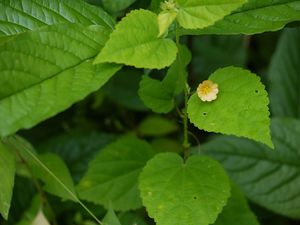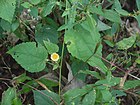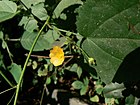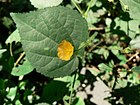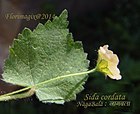Note: This is a project under development. The articles on this wiki are just being initiated and broadly incomplete. You can Help creating new pages.
Difference between revisions of "Sida cordata - Bhumibala"
(→External Links) |
(→References) |
||
| Line 81: | Line 81: | ||
<references> | <references> | ||
| − | <ref name="chemical composition">[https://en.wikipedia.org/wiki/Sida_cordifolia " | + | <ref name="chemical composition">[https://en.wikipedia.org/wiki/Sida_cordifolia "Phytochemistry"]</ref> |
<ref name="Leaf">[http://www.efloraofgandhinagar.in/herb/sida-cordata "eflora of gandinagar"]</ref> | <ref name="Leaf">[http://www.efloraofgandhinagar.in/herb/sida-cordata "eflora of gandinagar"]</ref> | ||
| − | <ref name="How to plant/cultivate">[http://herbalistics.com.au/product/sida-cordifolia-bala-seed/ " | + | <ref name="How to plant/cultivate">[http://herbalistics.com.au/product/sida-cordifolia-bala-seed/ "Care and Cultivation"]</ref> |
</references> | </references> | ||
Revision as of 15:35, 3 May 2018
Bhumibala or Sida cordata is a perennial plant producing more or less herbaceous, procumbent stems up to 1 metre long from a woody rootstock.The plant is harvested from the wild for local medicinal use / Ayurvedic medicine and source of fibre.The juice of the plant is applied to boils and pimples.The root is tonic. The juice of the root is used to treat indigestion. A paste of the root is applied as a poultice to remove pus from boils and wounds. It is also used in the treatment of gonorrhoea and other venereal diseases.The juice of the leaves is used to treat cuts and wounds.
Contents
Uses
boils, pimples, indigestion, boils, wounds, gonorrhoea, venereal diseases, cuts.
Parts Used
bark.
Chemical Composition
The following alkaloids were reported from S. cordifolia growing in India β-phenethylamine, ephedrine, pseudo-ephedrine, S-(+)-Nb-methyltryptophan methyl ester, hypaphorine, vasicinone, vasicinol, choline, and betaine[1]
Common names
| Language | Common name |
|---|---|
| Kannada | Bekkinathale Gida, Bekkina thale gida |
| Hindi | Bhyunli, Bananiyar, Andiobal |
| Malayalam | Palkurunthotti, Vallikurunthotti, Nela-vaga |
| Tamil | Kurunthotti, Palampaci |
| Telugu | Gayapuvaku, Benda, Tirunala |
| Marathi | NA |
| Gujarathi | NA |
| Punjabi | NA |
| Kashmiri | NA |
| Sanskrit | Bhumibala, Nagabala |
| English | Heart leaf |
Habit
Identification
Leaf
| Kind | Shape | Feature |
|---|---|---|
| Cordate | ovate | Leaves areacute or acuminate, serrate |
Flower
| Type | Size | Color and composition | Stamen | More information |
|---|---|---|---|---|
| Unisexual | 2-4cm long | Yellow | 5 | axillary, solitary or in clusters at the ends of the branches |
Fruit
| Type | Size | Mass | Appearance | Seeds | More information |
|---|---|---|---|---|---|
| Globose | 7–10 mm (0.28–0.4 in.) long pome | clearly grooved lengthwise, Lowest hooked hairs aligned towards crown | Fruiting Time is October - November | Seeds brown | {{{6}}} |
Other features
List of Ayurvedic medicine in which the herb is used
- Vishatinduka Taila as root juice extract
Where to get the saplings
Mode of Propagation
How to plant/cultivate
Seed can be sown in late autumn/spring/summer. Either sow directly into ground or in a pot. Lightly cover with soil and keep moist until they begin to germinate[3]
Commonly seen growing in areas
Scrub, grassy roadsides in china, Uncultivated land, undergrowth in forest.
Photo Gallery
References
External Links
- Pages that are stubs
- Ayurvedic Herbs known to be helpful to treat boils
- Ayurvedic Herbs known to be helpful to treat pimples
- Ayurvedic Herbs known to be helpful to treat indigestion
- Ayurvedic Herbs known to be helpful to treat wounds
- Ayurvedic Herbs known to be helpful to treat gonorrhoea
- Ayurvedic Herbs known to be helpful to treat venereal diseases
- Ayurvedic Herbs known to be helpful to treat cuts
- Herbs with bark used in medicine
- Herbs with common name in Kannada
- Herbs with common name in Hindi
- Herbs with common name in Malayalam
- Herbs with common name in Tamil
- Herbs with common name in Telugu
- Herbs with common name in Sanskrit
- Herbs with common name in English
- Habit - perennial herb
- Index of Plants which can be propagated by Seeds
- Herbs that are commonly seen in the region of Scrub, grassy roadsides in china
- Herbs that are commonly seen in the region of Uncultivated land
- Herbs that are commonly seen in the region of undergrowth in forest
- Herbs
